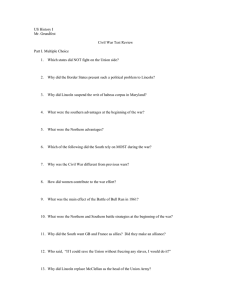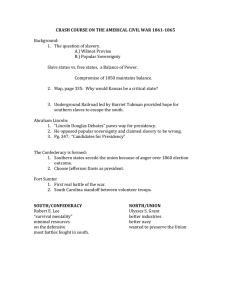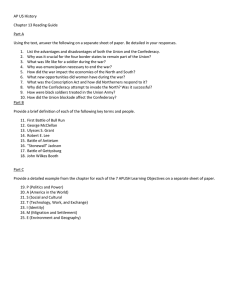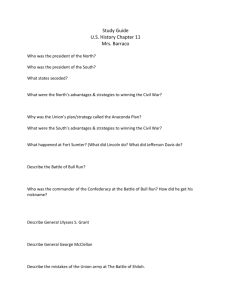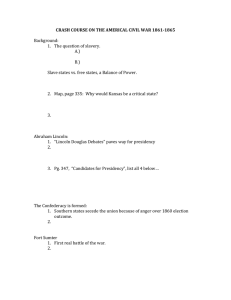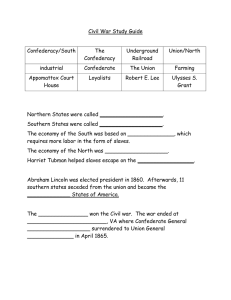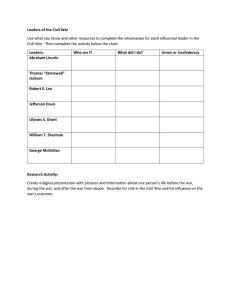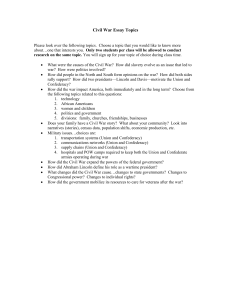The Civil War
advertisement
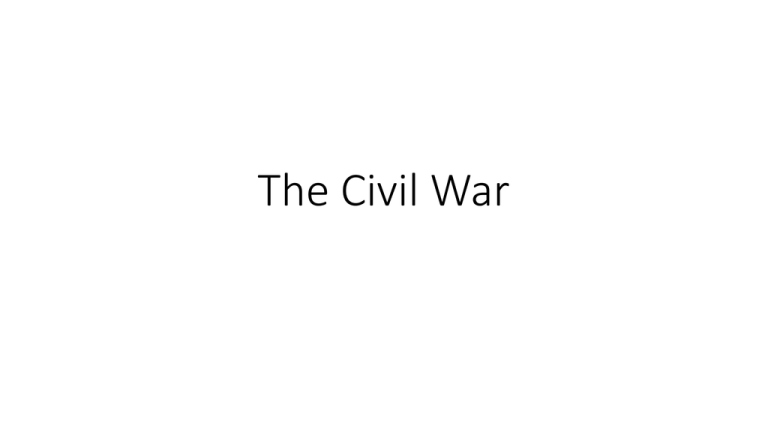
The Civil War The Goals of the War The Union The Confederacy At the onset of the War the Union was fighting to reunite the Nation and bring the southern states back to the Union. They were fighting for state rights. The right to own slaves. After the Emancipation Proclamation the goal of the War changed to that of one to end slavery. They believed if they outlasted the North, and dragged out the War, eventually the North would grow tired and allow the Confederacy to exist. Lincoln initially did not support ending slavery in the South, only limiting the expansion of slavery into the West. The North’s (Union) Advantages The North’s manufacturing capabilities meant they could mass produce the weapons and tools needed for war. Manufacturing Population Advantages Transportation The North had better railroads, highways, canals, and naval ports. They could more easily ship goods to the battle field than the South. The North was the destination for many European Immigrants. They took jobs in factories, this meant that the workforce was not depleted and could continue to produce the materials for war. The South’s (Confederacy) Advantages Much of the fighting was done in the South. Southerners had the “home field advantage.” They were much more familiar with the landscape. Terrain Generals Advantages Transportation Robert E. Lee and Stonewall Jackson were some of the best military minds in the country, and both supported the Southern cause. They made the South a formidable foe. Leaders Union Confederacy Jefferson DavisPresident Abraham Lincoln President Ulysses S. Grant– Most effective Union General Robert E. LeeBest Confederate General “Stonewall” JacksonConfederacy’s 2nd best General The Battle of Fort Sumter The first shots of the Civil War were fired at Ft. Sumter, South Carolina. Union forces would not surrender the fort to the Confederacy, which then proceeded to bombard the fort. The Battle of Antietam The single bloodiest day of the Civil War. First battle of the Civil War to be fought on Union soil. It was somewhat of a tactical victory for the Union, it led to Lincoln issuing the Emancipation Proclamation. Emancipation Proclamation • It freed slaves in the Confederacy only! • The Emancipation Proclamation did not free many slaves in reality. • Only runaway slaves from the south that found their way to the North were free. • It did not free slaves in the Union borders states. • It changed the goal of the War for the Union, they would now be fighting to end slavery. The Battle of Gettysburg The Confederacy planned to invade the North. It was the 1st turning point battle of the War. The Union victory prevented the Confederacy from invading the North ever again. Battle of Vicksburg, Mississippi The 2nd turning point battle of the Civil War. Union forces, led by Ulysses S. Grant gained control of the Mississippi River with this victory. This cut the Confederacy in half. Passing of the th 13 The 13th Amendment was ratified on January 31, 1865. This ended Slavery in America. It also meant that the Southern states that seceded would have to abolish slavery if the Union won. Amendment Surrender at Appomattox Courthouse, Virginia Facing inevitable defeat, Robert E. Lee surrendered to Ulysses S. Grant on April 9, 1865. This was the end of the Civil War. The Assassination of Abraham Lincoln • Abraham Lincoln was assassinated by John Wilkes Booth, an actor and supporter of the Confederacy on April 14th, 1865. Just a few days after Lee’s surrender. • Lincoln died the next day. • The nation mourned his death, and the consequences of his assassination meant the nation would be without his leadership during Reconstruction.
